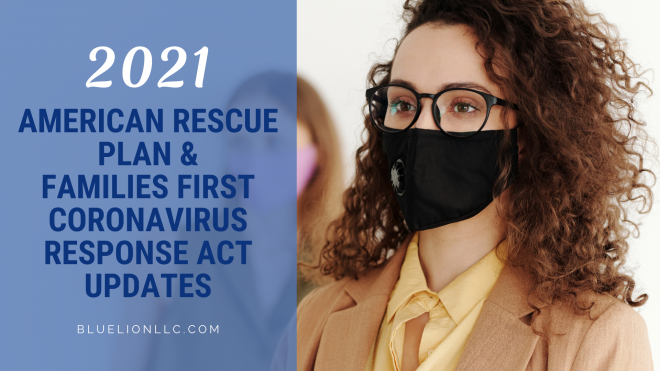
President Joe Biden signed a new $1.9 trillion American Rescue Plan Act of 2021 (ARPA) into effect on March 11, 2021. This expansion of the Families First Coronavirus Response Act (FFCRA) still applies to employers with fewer than 500 employees.
Several significant provisions of the act affect both small and large companies, including:
- A 100% COBRA subsidy
- Emergency paid leave
- Unemployment insurance programs
- Employee retention credit
We’re covering the major changes, extensions, and tax credit details below. Read on for the breakdown of these important updates and how they apply to employers.
COBRA Subsidy Program
Under the ARPA, the federal government will now pay 100% of COBRA insurance premiums for eligible employees who lost their jobs and their covered relatives.
The Breakdown
- Begins on April 1, 2021, and ends on September 30, 2021
- Employers will obtain the subsidy through a payroll tax credit against their quarterly taxes.
- Employers will be responsible for paying health insurance carriers for the premiums.
- Fully insured and self-insured group health plans subject to federal COBRA are eligible for the credit against their Medicare FICA payroll taxes.
- Health plans must provide COBRA premium subsidy to assistance-eligible individuals (AEIs) who have elected COBRA coverage.
Note: If your credit exceeds the amount of payroll taxes due, you will receive a refund by submitting Form 941.
Eligible Individuals
Employees must be AEIs to qualify for a subsidy. An AEI qualifies if they are eligible for COBRA coverage between April 1 and September 30, 2021, due to involuntary termination or a reduction in hours, and elects coverage.
Individuals who do not qualify include:
- An AEI who becomes eligible for other group health plan coverage (that is not an excepted benefit) or Medicare.
- An AEI who has reached their maximum COBRA period.
- Employees who end employment voluntarily are not eligible.
Ensure that AEIs know that they must notify their group health plan if they become eligible for other ACA-compliant coverage during the subsidy period—even if they choose not to enroll in the alternative coverage.
Special Enrollment Period
A terminated worker who is eligible for assistance and:
- Hasn’t elected COBRA coverage by April 1, or
- Elected COBRA coverage but then discontinued it.
Eligible individuals may elect COBRA coverage during this period starting April 1 and ending 60 days after the date on which the COBRA notification was delivered.
Additionally, individuals will not have to elect and pay for COBRA retroactively for months before the subsidy becoming available.
Employer Notice Requirements
By May 30, employers’ COBRA notices must include information about the subsidy’s availability and the special 60-day enrollment period for qualified beneficiaries. You can add this information to either your current COBRA notices or provide it in a separate document.
Contact BlueLion today for guidance on COBRA notifications and requirements regarding the ARPA updates.
Emergency Paid Leave
The ARPA has also updated the qualifying reasons and tax credits for emergency paid leave. Providing paid sick or family medical leave is no longer mandatory, but employers may offer employees leave for qualifying reasons and enjoy tax credits.
The Breakdown
While the original qualifying reasons for leave under the original FFCRA remain the same, the tax credit is now available for leave taken to:
- Obtain the COVID-19 vaccine.
- Recover “from any injury, disability, illness, or condition related to” the COVID-19 vaccine.
- Quarantine or obtain a COVID-19 test or diagnosis at the employer’s request.
The new law also:
- Provides a refreshed bank of 10 additional days of paid sick leave as of April 1, 2021, eligible for the tax credit. This applies even if employees exhausted their leave under the original FFCRA.
- Expands the total cap for paid leave (and tax credits) under the Emergency Family and Medical Leave Expansion Act (EFMLEA) from $10,000 to $12,000. The two weeks of leave available under the Emergency Paid Sick Leave Act (EPSLA) are now EFMLEA leave for all purposes (not only to care for a child when the child’s school or place of care is closed).
- States that employees will receive either 100% (max of $511/day) or two-thirds (max of $200/day) of pay for the 10 days of emergency paid sick leave, depending on the reason for leave. Employees will receive two-thirds of their pay (max of $200/day) starting on Day 11 when emergency family medical leave begins.
Unemployment Insurance Programs
The ARPA has expanded the original CARES Act unemployment insurance programs as follows:
Pandemic Emergency Unemployment Compensation (PEUC)
Provides additional assistance to individuals who have exhausted their state law unemployment benefits
The Breakdown
- Originally provided up to 13 weeks of benefits and expired on December 31, 2020
- Consolidated Appropriations Act (CAA) extended benefits to up to 24 weeks through March 14, 2021
- ARPA extends benefits up to 53 weeks through September 6, 2021
Pandemic Unemployment Assistance (PUA)
The PUA assists unemployed individuals who are not eligible for regular or unemployment insurance, such as:
- Business owners
- Self-employed workers
- Independent contractors
- Individuals without a sufficient work history
- Individuals not covered by regular unemployment compensation or the unemployment compensation programs under state laws
The Breakdown
- Originally provided up to 39 weeks of unemployment benefits and expired on December 31, 2020
- CAA extended benefits up to 50 weeks through March 14, 2021
- ARPA now provides up to 79 weeks of unemployment benefits (and up to 86 weeks for individuals in states with high unemployment levels) through September 6, 2021.
Federal Pandemic Unemployment Compensation (FPUC)
The FPUC program is the weekly stipend provided as a supplement to the state unemployment benefits.
The Breakdown
- Originally provided $600 per week and was set to expire July 31, 2020
- CAA extended through March 14, 2021, at a reduced rate of $300 per week
- ARPA extends $300 in supplemental benefits through September 6, 2021
Mixed Earner Unemployment Compensation (MEUC)
Provides financial assistance to freelancers and gig economy workers who:
- Receive at least $5,000 in self-employment income;
- Are not receiving benefits under the PUA; and
- Are eligible to receive at least one dollar in state unemployment benefits during the period covered by the program.
The Breakdown
- Provides an additional $100 in supplemental benefits to eligible individuals
- ARPA extended through September 6, 2021
Employee Retention Credit
The Employee Retention Credit (ERC) was part of the original CARES Act and expanded under the Consolidated Appropriations Act. It is meant to help employers who were struggling financially or had to close due to COVID-19.
The ERC is a payroll tax credit for eligible employers based on the amount of qualified wages they paid to certain employees. The goal is to encourage employers to keep their employees.
The Breakdown
- CARES Act: Tax credit was capped at $5,000 per employee for 2020
- CAA: Expanded to qualified wages paid between January 1, 2021, and June 30, 2021, and increased max credit to $7,000 per employee per quarter
- ARPA Updates: Extends through the end of 2021 and expands eligibility to certain employers
Newly eligible businesses include:
- Recovery startup businesses that began business after February 15, 2020, have gross annual receipts of up to $1 million, and are otherwise ineligible under the eligibility test,
- Severely financially distressed employers (i.e., companies with gross receipt reductions of more than 90% as compared to the same quarter in 2019).
Get Assistance on COVID-19 Relief & Employment Laws
This new wave of COVID-19 recovery provisions under the ARPA might seem like a lot to digest. While we’ve covered the highlights above, employers must follow many details and requirements under the new FFRCA.
If you need assistance navigating the new legislation and making sure your company remains compliant, contact BlueLion today at 603-818-4131 or info@bluelionllc.com. Our team of HR professionals is always up-to-date on employment laws and will be happy to guide you through the many changes.
The information on this website, including its newsletters, is not, nor is it intended to be legal advice. You should contact an attorney or HR specialist for advice on your individual situation.


